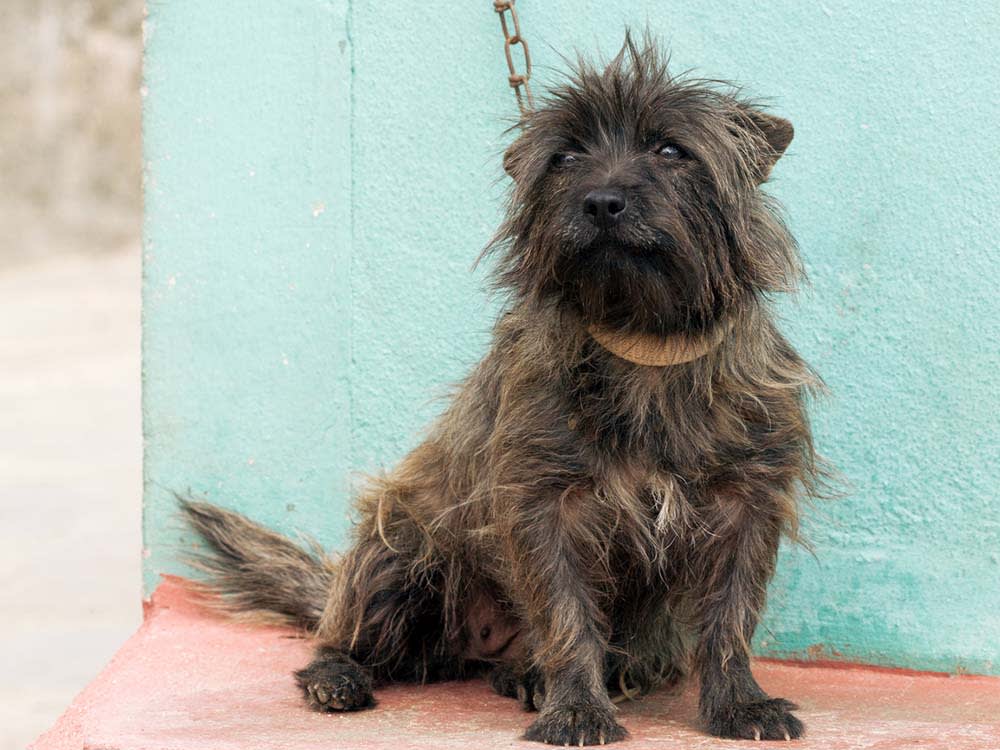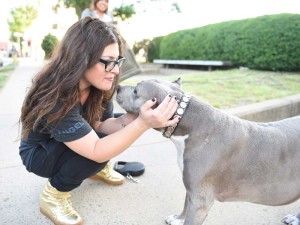Breaking the Chains
A new law bans chaining up dogs outside in Texas.
New year, new laws. You’ve probably seen the reports about legislation that just took effect to legalize to-go cocktails and illegalize surprise medical bills — awesome! But wait, it gets better. As of this month, it will be illegal to chain up a dog outside in Texas. Across the country, hundreds of pets are left outdoors, restrained by heavy chains, in blistering heat or freezing cold.
From now on, any outdoor restraint must be lighter and more flexible, and dogs must have adequate shelter, shade, and water. Fines can go up to $500 for first offenses; repeat offenders can get jail time. “Too many dogs are seen like burglar alarms or some sort of security device instead of the living beings that they are, and they’re kept in chains,” said Rachel Wolf of animal rights org Voice for Animals. Governor Greg Abbott actually vetoed the law at first, but then caved following a Tweet blitz with the hashtag #AbbottHatesDogs.
In other good news, a new law in Nevada makes it illegal for insurance companies to deny coverage to homeowners or charge more based on their dogs’ breed, following suit in abolishing antiquated breed-specific legislation like New York did last month. But back to the chain ban. If you’re wondering why this is such an important step forward, below is some info from the Humane Society on why chaining up dogs outside is so, well, wrong.
Why would someone chain up their pet in the first place?
People tether their dogs for a variety of reasons. Most people who do this are unaware of the harm it can cause their dogs. Social norms of pet-keeping have made tethering unpopular, so it is declining as a practice, but some reasons people do it include:
How much do you spend on your pet per year?
The dog is a repeat escapee and the owner has run out of ideas to safely confine the dog. Sometimes this is the reason dogs are kept on heavier chains — they have chewed through or otherwise escaped lighter tethers and the owner is trying to keep them from getting loose.
The owner is trying to protect their dog from something on the other side of their fence (kids, another dog, etc.) by keeping the dog in one area in the yard.
The owner's fence is damaged or the owner doesn't have a fenced yard.
The dog’s behavior makes keeping them indoors challenging and the owner doesn’t know how to correct the behavior.
The landlord may not allow the pet owner to keep the dog indoors or install a fence.
The pet owner comes from a family that always tethered dogs and may not realize there are better options.
Why is chaining up a dog bad for them?
Dogs are naturally social beings who need interaction with humans and/or other animals. Intensive confinement or long-term restraint can severely damage their physical and psychological well-being. An otherwise friendly and docile dog, when kept continuously chained or intensively confined in any way, becomes neurotic, unhappy, anxious and often aggressive.
It is common for continuously tethered dogs to endure physical ailments as a result of being continuously tethered. Their necks can become raw and sore and their collars can painfully grow into their skin. They are vulnerable to insect bites and parasites and are at high risk of entanglement, strangulation and harassment or attacks by other dogs or people.
Tethered dogs may also suffer from irregular feedings, overturned water bowls, inadequate veterinary care, and extreme temperatures. During snow storms, these dogs often have no access to shelter. During periods of extreme heat, they may not receive adequate water or protection from the sun. Owners who chain their dogs are less likely to clean the area of confinement, causing the dogs to eat and sleep in an area contaminated with urine and feces.
Why is chaining up dogs also a danger to humans?
Tethering is not only bad for dogs — it is a high-risk factor in serious dog bites and attacks. Dogs unable to retreat from perceived or real threats can act out aggressively when approached. Dogs tethered for long periods can become highly aggressive. Dogs feel naturally protective of their territory; when confronted with a perceived threat, they respond according to their fight-or-flight instinct. A tie-up dog, unable to take flight, resorts to fight, attacking any unfamiliar animal or person who unwittingly wanders into his or her territory.
What about attaching a dog’s leash to a “pulley run”?
Attaching a dog’s leash to a long line — such as a clothesline or a manufactured device known as a pulley run — and letting the animal have a larger area in which to explore is preferable to tethering the dog to a stationary object. However, many of the same risks associated with tethering still apply, including hanging, attacks on or by other animals, lack of socialization, and safety.
What can I do to help chained/tethered dogs?
Find out if your community (city, county, township, and even some states) has laws regulating tethering. If not, consider working with community officials to create regulations in your local ordinance. Visit our section on how to pass a tethering law for more information. If your local animal services agency is well funded and effectively enforcing basic laws, adding tethering regulations may be a good idea. If not, take a step back and evaluate what is needed to strengthen existing resources and efforts.
If you are concerned about a specific dog who is tethered, you may want to consider asking your local animal care and control agency to pay the owner a visit. Even if tethering is legal, agents can make a friendly visit to see if they can improve the situation by helping the owner troubleshoot and gather resources to address the problem at its root (i.e. a behavior problem or repeated escapes). Most situations can be improved through positive engagement and support services; punitive measures can be used to address the most egregious of situations.
Trying to address dog chaining by “rescuing” all tethered dogs is not recommended for a number of reasons. First, most owners care about and want their dogs, and it is critical to try and keep as many animals as possible in the homes they already have. Second, the owner is likely to replace the dog and tether future dogs. Removing the dog adds to the already overwhelming number of dogs competing for homes, and an animal sheltering and rescue infrastructure which is already well above capacity. Working with owners to improve the situations for their existing dogs is always the best option and our experience shows that most people are open to support.





